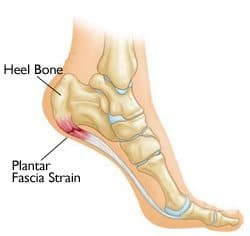 If you’re suffering from any kind of pain in foot arch, heel or midfoot, you could have a condition called plantar fasciitis, or also known as heel spur syndrome. According to The Podiatry Institute it accounts for 15% of all reported foot disorders and leaves approximately 2 million Americans seeking medical help each year. It is one of the most common foot problems diagnosed by doctors, and with a staggering 1 in 10 people experiencing the discomfort at least once in their lifetime, it’s a serious condition which can cause severe pain sometimes in both feet at once. Considering the pain can be prevented in the first place, or relief provided if it does occur, 10% is still a huge amount of people who are suffering, perhaps without knowing how easy it is to prevent or provide treatment. Please see below for more information on the symptoms, causes and some of the non-surgery methods of treatment which are available.
If you’re suffering from any kind of pain in foot arch, heel or midfoot, you could have a condition called plantar fasciitis, or also known as heel spur syndrome. According to The Podiatry Institute it accounts for 15% of all reported foot disorders and leaves approximately 2 million Americans seeking medical help each year. It is one of the most common foot problems diagnosed by doctors, and with a staggering 1 in 10 people experiencing the discomfort at least once in their lifetime, it’s a serious condition which can cause severe pain sometimes in both feet at once. Considering the pain can be prevented in the first place, or relief provided if it does occur, 10% is still a huge amount of people who are suffering, perhaps without knowing how easy it is to prevent or provide treatment. Please see below for more information on the symptoms, causes and some of the non-surgery methods of treatment which are available.
Quick Navigation
What Causes Plantar Fasciitis?
The inflammation of the plantar fascia which leads to pain in feet can be due to tissue damage or injury, or can be because of an accumulation of smaller injuries over the years. These injuries could also be due to having flat feet, overpronation of the foot, excessive running which stresses the tissue, standing on your feet all day especially on hard surfaces for prolonged periods of time, or increased weight and pressure on feet due to obesity.
However, one of the most common and more importantly the most controllable causes of plantar fasciitis is because of inappropriate footwear being worn. This would entail wearing old sneakers that are too flexible, worn out and provide poor lateral support, or those which have weak arch supports and thin soles. See below for more advice on how this can be resolved.
Detailed Explanation By A Podiatrist
A podiatrist by the name of Dr. Julia Overstreet shows you all the basics to safely evaluate and treat heel spur syndrome.
How To Treat Plantar Fasciitis
Here are some simple protocols of treatment for plantar fasciitis which could be the path to a pain free foot within 2-4 weeks:
Low Dye Taping
One of the first courses of plantar fasciitis treatment a podiatrist will recommend is low dye taping (also known as foot strapping or foot taping). This addresses pronation in stance or abnormal gait by specially wrapping tape around the affected areas of the heel, ankle and arch.
Orthotics For Shoes
The second most important piece of advice a podiatrist can recommend is to use orthopedic or orthotic shoe inserts, also known as arch support insoles. Orthotic insoles can be purchased almost anywhere, whether online, local drug store or athletics stores. They are to replace the current shoe insole throughout the duration of the treatment, and must be worn continually, even when at home; every step that is taken where the arch is fallen the orthotics must be in place. A good way to check you have the correct orthopedic insoles is to hold them up against the foot to make sure it fits the arch. If you’re having trouble finding ones which fit you may need custom orthotics.
New Shoes
One of the cheapest and most effective routes to treatment is to ensure you’re wearing new, and, good footwear. The shoes for plantar fasciitis are ones which provide support to the heel and arch. Most people own their footwear for years, and keep them in pristine condition even though they may be used daily. However, although your shoes may look new, the internal structure is broken down and not providing support. Most everyday walking shoes and even running shoes are only suffice for about 300 miles of usage, which doesn’t take long to clock up if worn regularly. Therefore ensure you have new orthotic friendly shoes, and hopefully results will be felt almost immediately.
Night Splints
Night splints are used for wearing in bed to keep the foot at a 90 degree angle overnight so the arches can’t relax and enter a position which can be later stretched. Primarily it’s to ensure the arch doesn’t tear first thing in the morning when taking those painful first steps which are typical symptoms of heel spur syndrome. Night splints are bulky, an annoyance for some, and relatively expensive, however they’re known to work well.
